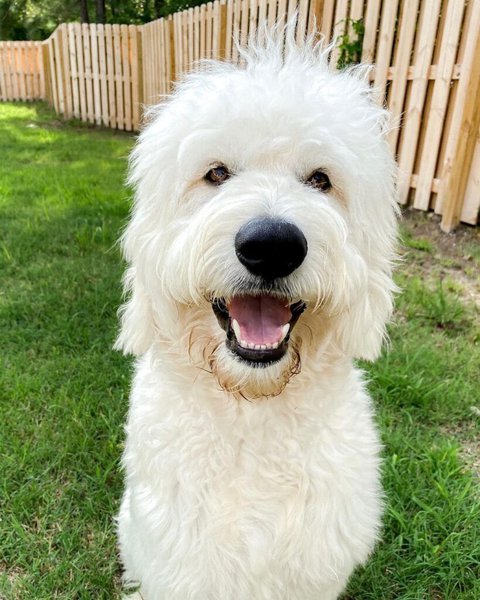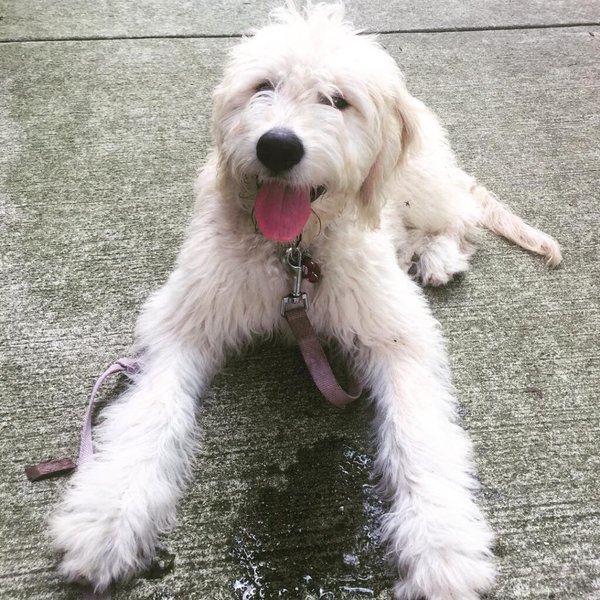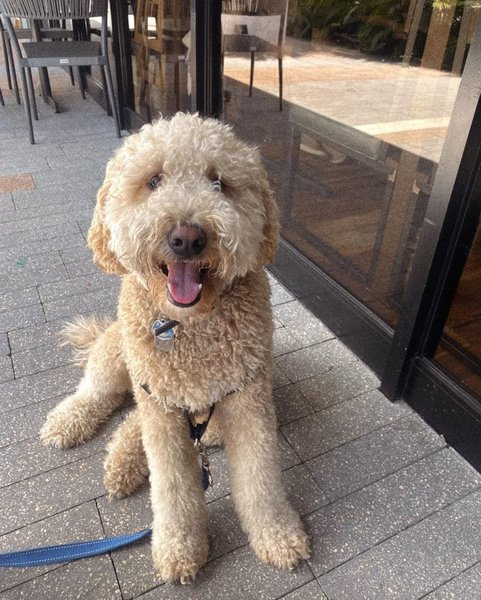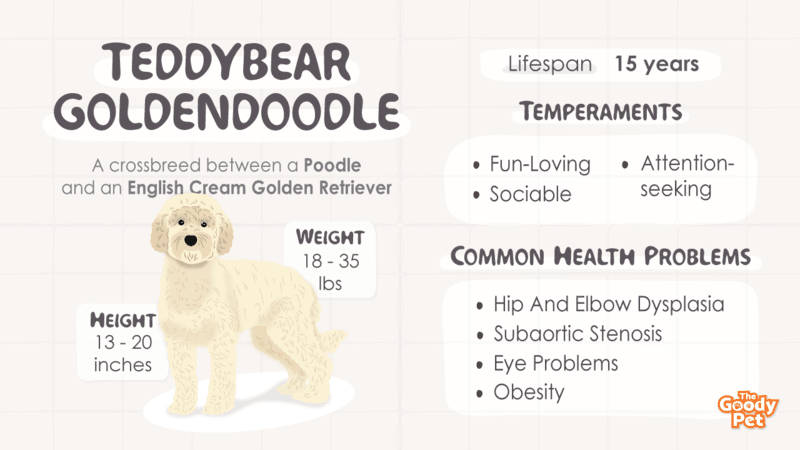We have all been through a time when a cute teddy bear used to be our favorite life companion. No one could imagine having a real moving teddy bear as a companion in life. Fortunately, with the modern development of designer breed dogs, one need not imagine further when looking at a Teddy Bear Goldendoodle.
The Teddy Bear Goldendoodle, or English Goldendoodle, is the crossbreed between a Poodle and an English Cream Golden Retriever. In terms of temperament and physique, a Teddy Bear Goldendoodle is not much different from any other regular Goldendoodles.
What sets this pooch apart from regular Goldendoodles is the specified choice of the English Cream Golden Retriever for breeding. Selecting a regular American Golden Retriever will result in a regular Goldendoodle. Hence, the Teddy Bear Goldendoodle often goes by English Goldendoodle or English Cream Goldendoodles. However, this name totally doesn’t limit the pooches of this breed to cream coat color only.
Well, down below, you’ll get to know even more interesting stuff about these cute pooches, including their funny traits, health concerns, lifespan, grooming needs, and much more. But before all that, let’s discover the “teddy-bear looks” of these hairy buddies!
What Is An F1 Teddy Bear Goldendoodle?
To break down the terms for simplicity sake, the term ‘F1’ here refers to a first generation crossbreed, while the ‘Teddy Bear Goldendoodle’ term, as mentioned previously, refers to a cross between a Poodle and an English Golden Retriever.
Physical Appearance
Teddy Bear Goldendoodles are famous for having real teddy bear looks. You will be surprised to know that the dark eyes of these pooches are just like the button ones we have had on our teddy bear toys.
Their faces are typically round in shape with tons of innocence and cuteness overloaded on. The hairs throughout their coat are super wavy or curly which gives a natural teddy bear fluffy feel.
Well, it can be said that almost all the kinds of Goldendoodles look like teddy bears. However, still, it largely depends on to what extent their coats get curly or wavy.
Teddy Bear Goldendoodles generally produce coats wavier than their generic Goldendoodle fellows since the English Golden Retriever parents tend to own coats wavier than regular Golden Retriever parents.

Size
Teddy Bear Goldendoodles are small to medium-breed canines, so they will grow to a size between 13 to 20 inches upon reaching full maturity. On the other hand, they typically weigh around 18 to 35 lbs.
Given their adorable petite sizes, these canines love to remain lap dogs even after getting maturity. You would love to cuddle or lift them so often, as though they are not that heavy.
Coat
The coat color of this breed is not limited to yellowish or cream color only. English Goldendoodles come in a wide range of colors since their Poodle parents exist in tons of bright and dark colors.
The Teddy Bear Goldendoodle can be cream-colored, red-colored, gray-colored, or of any color its Poodle parents usually come in.
Owners usually love giving their English Goldendoodles a teddy bear cut. The addition of this teddy bear haircut on an existing teddy-bear look makes everything super wonderful. A teddy bear cut gives the pooch an equal hair length of 1 to 2 inches throughout the entire coat.
How Long Do Teddy Bear Goldendoodles Live?
Teddy Bear Goldendoodles are small breed canines that can live up to 15 years.
The breed does not come up with any significant health concerns; in fact, canines from this breed seem to be healthier than their purebred parents. Still, here are a few health issues a Teddy Bear buddy can inherit from her parents.
Subaortic Stenosis
Teddy Bear Goldendoodles may face a heart disease named subaortic stenosis which is also found to be common among their Golden Retriever parents.
In this case, the left ventricle of the heart tends to get narrowed, consequently disturbing the blood flow toward the aorta blood vessel. Fatigue and chest pain are common symptoms. However, the issue can be resolved with the help of medication or surgery.
Hip And Elbow Dysplasia
Another health issue affecting Teddy Bear Goldendoodles is hip and elbow dysplasia that is likely to originate from their Golden Retriever parents. Both elbow and hip dysplasia occur due to the displacement of joint bones fixed into each other.
This displacement causes severe pain in the affected part, consequently causing lameness in your pooch. Therapies and vet-prescribed exercises, however, help the pooch to get quick recovery.

Eye Problems
Some of the eye problems a Teddy Bear Goldendoodle may be prone to include progressive retinal atrophy, cataracts, and glaucoma.
A cataract disease makes the vision of this pooch blurred, whereas progressive retinal atrophy leads to day and night vision losses. Both conditions will cause the Teddy Bear Goldendoodle to suffer from complete blindness in its later years.
On the other hand, in the case of glaucoma, the eye nerve connecting to the brain, namely the optic nerve, gets damaged in your pooch’s body. The vision, in this case, gets affected in different ways.
Nevertheless, modern medication and surgery can help to manage all kinds of eye problems, so you just have to be there for your Teddy Bear Goldendoodle as it goes through the treatment process.
How To Take Care Of Your Teddybear Goldendoodle?
There are some key aspects to consider in providing the right care for your Teddy Bear Goldendoodle, such as an exercise routine, a high-quality diet, and not forgetting, dental care.
Exercise Routine
Almost all the Goldendoodle breed generations love hanging out and burning energy. So, the English Teddy Bear canines tend to require exercise of 20 to 30 minutes on a daily basis.
Teddy Bear Dogs are easy-to-handle pooches, so you’ll enjoy a park walk with your buddy every morning. You can also let your pooch spend some time playing with other neighbor canines when she tends to look super bored.
Moreover, if you have a backyard, you can help your pooch burn energy being at home by playing off-leash games like fetch.
The diet of English Goldendoodles mainly comprises protein and fats. Fibers, multivitamins, and little amounts of carbs, however, are the other basic components of their diet.
The intake of fat fulfills most of their energy requirements. Fibers, on the other hand, keep the digestive system of these furry friends in good working condition.
Serve your Teddy Goldendoodle 1 to 4 cups of kibbles divided into two meals every day. Well, you’ll need to have a trip to your vet to get a diet plan for your pooch crafted by analyzing its health, weight, and body size. You can also get a dog food delivery subscription made using human-grade ingredients while sitting at home using Pet Plate.
Dental Care
Try developing teeth brushing habits in your pooch from the very beginning to avoid oral issues during their senior years. In addition, get your pooch habitual to the use of dental water additives or dental chews to keep their mouth healthy and teeth strong.
Do Teddybear Goldendoodles Whine A Lot? Temperaments Of Teddybear Goldendoodles
Teddy Bear Goldendoodles usually whine when they want to communicate. They might be either seeking attention or might be trying to tell that they are in pain. Sometimes, Teddy Bear pooches whine on getting scared, so do give your attention every time these teddies tend to make annoying noises.
People-Oriented
English Goldendoodles love humans and enjoy being around them. These teddy bear pooches are not like other strong, bold pooches who seem totally fine with being alone for a long time. A Teddy Bear Goldendoodle can be left alone for 5 to 9 hours at most, still only when being kept occupied with toys and activities.
Otherwise, these pooches tend to face separation anxiety. Destructive behavior like aggressive chewing can also be a way of expressing loneliness in these little canines.

Fun-Loving
Teddy Bear Goldendoodles love playing with children and tend to become a child while being among them. They love having fun in water pools during hot sunny days.
Watching TV shows with close family members is one of their favorite hobbies. These pooches never make their owners feel alone and enjoy interacting with them all the time, so they are often seen working as therapy and service dogs.
Sociable And Sweet
English Goldendoodles tend to get friendly with every single person, including strangers and visitors. These curly coat buddies are eager and love to please everyone, such that they can be an ideal breed for extremely new pet owners.
The addition of the sweet temperament to their sensitive nature and cute looks makes the personality of these pooches super attractive.
How Do You Groom A Teddy Bear Goldendoodle? Grooming Tips For Teddybear Goldendoodles
Teddy Bear Goldendoodles produce a very small amount of dander and undergo little to no amount of shedding. This makes these canines hypoallergenic to some extent.
Besides, you won’t need to run a de-shedding tool on your pooch’s coat anymore; however, frequent brushing is a must for curly-coat type pooches.
Coat Brushing
Well, it depends on the hair length and whether your buddy requires daily brushing or brushing on alternate days. The coat hair length of around 1 to 2 inches would not generally require regular brushing. However, you’ll need to brush your Teddy Bear Goldendoodle every single day once she outgrows that short hair length.
The brush here we highly recommend is Hertzko Self Cleaning Slicker Brush. This comfortable-grip brush is super easy to use. You can run it fearlessly as it opens painful knots and tangles without hurting your lovely Teddy Bear Goldendoodle.
Bath
The curly coat of a Teddy Bear Goldendoodle tends to get matted every so often. This matted coat attracts debris easily, which then makes your pooch dirty and smelly. So, this pooch should be bathed once every month.
Use our recommended Pro Pet Works All Natural 5 In 1 Oatmeal Shampoo on your Teddy Bear Goldendoodle. A bath using this shampoo will clean your dog without drying her skin oil. Skin itching will not either bother your pooch’s fresh feel anymore!
Professional Grooming
A trip to a professional groomer is a must for Teddy Bear Goldendoodles, since their coats are curly and cannot be left looking messy.
Well, how often you’ll need to visit a groomer totally depends on how much you take care of your buddy’s coat, and definitely, the hair length you usually keep on her. The longer you keep the hair length, certainly, the less frequent the grooming trips will be.
Get your pooch a haircut once every 2 months if you generally keep her in longer clips. However, for pooches with short clips, a trip to the groomer should be scheduled every 8 to 10 weeks. This will cost you something between $50 to $80, depending on how ungroomed your hairy buddy is.
Related Questions
How Much Are Teddy Bear Goldendoodles? A Teddy Bear Goldendoodle puppy can cost you around $2,500 to $3,500. The current demand for Teddy Bear Goldendoodles is high all around the world and it will be expensive to get one. However, if you catch the breed giving a heart-stealing look at the breeder’s place, the costs will be worthwhile.
Do Teddy Bear Goldendoodles Swim? Teddy Bear Goldendoodles do swim. In fact, they love having fun in pools during hot summer days, given that their genetic parents are also known for loving water. The chlorine content in pools, however, affects Goldendoodle’s coats by making them matted. You’ll need to take care of its coat even more than before if she swims frequently.
What Is The Difference Between A Puppy Cut And A Teddy Bear Cut? The teddy bear cut will leave a resultant hair length longer than the puppy cut. Both the teddy bear cut and puppy cut are essentially the same style except for the aforementioned hair length difference. Both style cuts often describe a similarly cute fluffy canine look for Goldendoodles, so people occasionally mix up these two terms while conveying their ideas to a groomer.





